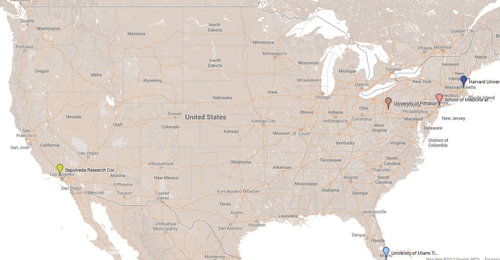Archived Content
The National Institute of Mental Health archives materials that are over 4 years old and no longer being updated. The content on this page is provided for historical reference purposes only and may not reflect current knowledge or information.
NeuroBioBank Gives Researchers One-stop Access to Post-mortem Brains
NIH Networks Five Brain Banks to Overcome Bottlenecks
• Press Release
To expedite research on brain disorders, the National Institutes of Health is shifting from a limited funding role to coordinating a Web-based resource for sharing post-mortem brain tissue. Under a NIH NeuroBioBank initiative, five brain banks will begin collaborating in a tissue sharing network for the neuroscience community.
“Instead of having to seek out brain tissue needed for a study from scattered repositories, researchers will have one-stop access to the specimens they need,” explained Thomas Insel, M.D., director of NIH’s National Institute of Mental Health (NIMH), one of three NIH institutes underwriting the project. “Such efficiency has become even more important with recent breakthrough technologies, such as CLARITY and resources such as BrainSpan that involve the use of human tissue.”
NIMH, the Eunice Kennedy Shriver National Institute of Child Health and Human Development (NICHD), and the National Institute of Neurological Disorders and Stroke (NINDS) announced funding of the federated network of five brain tissue repositories.
Historically, NIH institutes have awarded investigator-initiated grants to support disease-specific brain bank activities. The NIH NeuroBioBank instead employs contracts, which affords the agency a more interactive role.
Contracts totaling about $4.7 million for the 2013 fiscal year were awarded to brain banks at the Mount Sinai School of Medicine, New York City; Harvard University in Cambridge, Mass., the University of Miami; Sepulveda Research Corporation, Los Angeles; and the University of Pittsburgh.
These brain and tissue repositories seek out and accept brain donations, store the tissue, and distribute it to qualified researchers seeking to understand the causes of – and identify treatments and cures for – brain disorders, such as schizophrenia, multiple sclerosis , depression, epilepsy , Down syndrome , and autism. In addition to serving the research community, the NeuroBioBank website provides the public with information about the donation process and about how post-mortem tissue research advances knowledge about the disorders.
“While making a gift of a loved one’s brain to science may seem unsettling to many of us, brain tissue is a precious resource that enables progress in understanding and treating neurologic and psychiatric disorders,” said NINDS director Story Landis, Ph.D. "Donors are making an important contribution in advancing knowledge about the structure and function of our most complex organ."
The project seeks brain tissue from people with brain disorders and from non-affected individuals whose brains serve as controls in studies. Anyone age 18 years or older can register as potential donor, but next-of-kin can also give permission for donation of tissue from children and those who have not registered. The preferences and privacy of donors or their next-of-kin are respected in the process of sample collection.
"The NIH NeuroBioBank will offer economies of scale, increase availability of biospecimens, establish a standardized system, and raise public awareness of the importance of human brain research," said NICHD director Alan Guttmacher, M.D.
Other brain banks are encouraged to partner with the NeuroBioBank, by making their inventories available via the centralized website, he added.
See: Wanted: A Few Good Brains
Jill Bolte Taylor, Ph.D., a spokesperson for the Harvard Brain Tissue Resource Center, discusses why brain donation truly is the gift of hope.
About Brain Diseases and Disorders
Psychiatric and neurological disorders are common in the United States, resulting in significant loss in quality of life, interfering with family functioning and the ability to work. The likelihood of being diagnosed with a neurological disorder continues to increase with age, and the lengthening U.S. lifespan means more people will likely suffer from these disorders. In addition, neurodevelopmental disorders in children take a huge toll on quality of life for families. The need for research to further understand these disorders continues to be a priority, as is underscored by the President’s new BRAIN initiative .
Participating Brain Banks (see site for contact info)

For more information: www.neurobiobank.nih.gov
About the National Institute of Mental Health (NIMH): The mission of the NIMH is to transform the understanding and treatment of mental illnesses through basic and clinical research, paving the way for prevention, recovery and cure. For more information, visit the NIMH website.
The National Institute of Neurological Disorders and Stroke (NINDS ) is the nation’s leading funder of research on the brain and nervous system. The mission of NINDS is to seek fundamental knowledge about the brain and nervous system and to use that knowledge to reduce the burden of neurological disease.
About the Eunice Kennedy Shriver National Institute of Child Health and Human Development (NICHD): The NICHD sponsors research on development, before and after birth; maternal, child, and family health; reproductive biology and population issues; and medical rehabilitation. For more information, visit the NICHD website.
About the National Institutes of Health (NIH): NIH, the nation's medical research agency, includes 27 Institutes and Centers and is a component of the U.S. Department of Health and Human Services. NIH is the primary federal agency conducting and supporting basic, clinical, and translational medical research, and is investigating the causes, treatments, and cures for both common and rare diseases. For more information about NIH and its programs, visit the NIH website .
NIH…Turning Discovery Into Health®
